Mahasim, Theta Aurigae A (θ Aur A), is the primary component in a binary star system located in the northern constellation Auriga. With an apparent magnitude that varies from 2.62 to 2.70, Mahasim is the third brightest star in Auriga, after Capella and Menkalinan. It lies at a distance of 166 light years from Earth.
Star system
Theta Aurigae is a double star consisting of Theta Aurigae A (Mahasim), a white, chemically peculiar star with the stellar classification A0pSi, and Theta Aurigae B, a white main sequence star of the spectral type F2-5V.
The primary component has a mass about 3.38 times that of the Sun and a radius 5.1 times solar. With an effective temperature of about 10,400 K, it is 263 times more luminous than the Sun. The star spins with a projected rotational velocity of 55 km/s, completing a rotation every 3.6187 days. The “pSi” suffix in its spectral type indicates an overabundance of silicon.
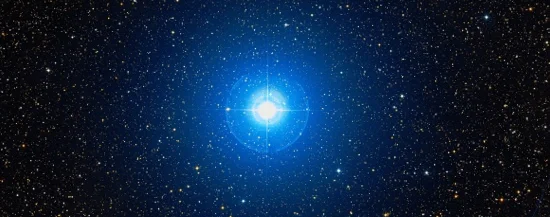
Mahasim (Theta Aurigae), image: Wikisky
Mahasim is classified as an Alpha2 Canum Venaticorum variable. Named after the prototype Cor Caroli (Alpha2 CVn), Alpha2 CVn variables are chemically peculiar main sequence stars with strong magnetic fields and strong lines of silicon, strontium or chromium in their spectra. They exhibit variations in brightness by 0.01 to 0.1 magnitudes with periods of 0.5 to 160 days. The periods correspond to stars’ rotational periods. The brightness variations are believed to be caused by an uneven distribution of metals in the stars’ atmospheres, which causes the brightness to vary from point to point. Other variable stars of this type include Alioth and Alpha Doradus, the brightest stars in the constellations Ursa Major and Dorado.
Theta Aurigae B is separated by 3.91 arcseconds from the primary. It is a white main sequence star with an apparent magnitude of 7.2.
Theta Aurigae is an X-ray source with an output of 9.49 × 1026 erg s−1.
The Theta Aurigae system has a combined apparent magnitude of 2.65, but the brightness fluctuations of Theta Aurigae A cause the system’s brightness to vary from magnitude 2.62 to 2.70 with a period of 1.37 days.
The Catalog of Components of Double and Multiple stars lists a total of four stars in the system, designated Theta Aurigae A (mag. 2.7), B (mag. 7.2), C (mag. 10.7), and D (mag. 9.2).
Facts
Mahasim is one of the bright stars that form the pentagon asterism that makes Auriga constellation easily recognizable. The stars that mark the other vertices of the pentagon are Capella (Alpha Aurigae), Menkalinan (Beta Aurigae), Hassaleh (Iota Aurigae), and Elnath (Beta Tauri). The fainter Almaaz (Epsilon Aurigae) near Capella makes the pattern a hexagon. Mahasim is the fourth brightest star in the asterism, after Capella, Elnath and Menkalinan.
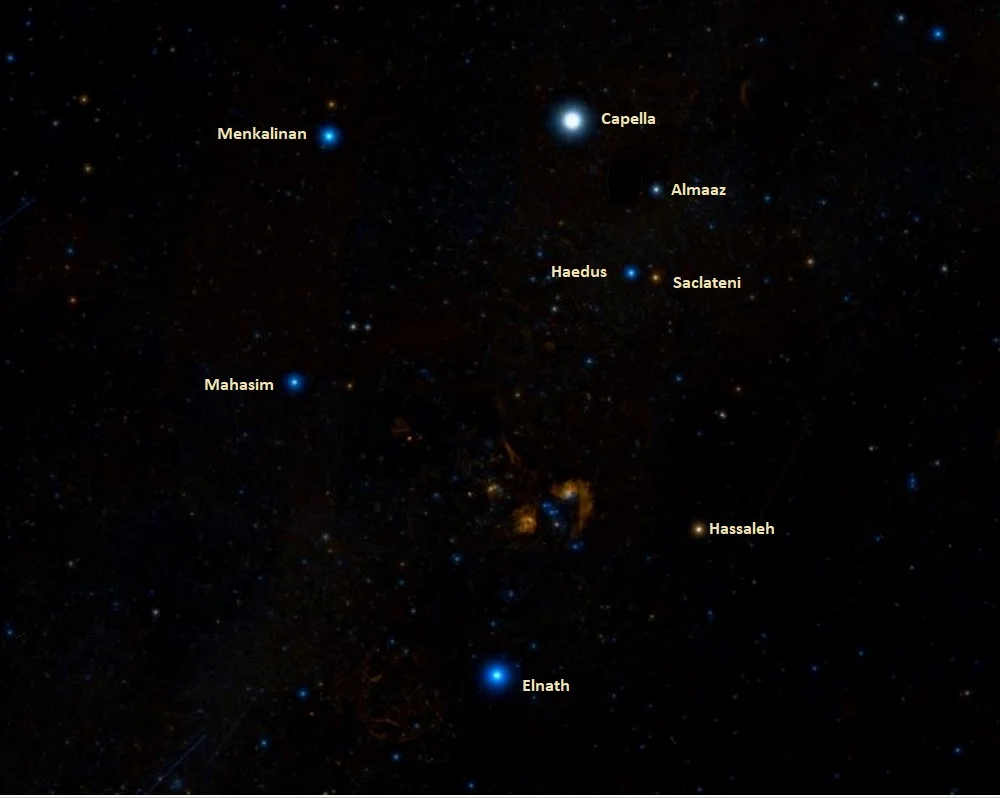
Auriga stars, image: Wikisky
Name
The name Mahasim is derived from the Arabic al-miʽşam, meaning “the wrist.” It refers to the wrist of Auriga, the Charioteer.
The name was officially approved by the International Astronomical Union’s (IAU) Working Group on Star Names (WGSN) on June 30, 2017. It formally applies only to the component Theta Aurigae A.
Theta Aurigae once shared the name Mahasim with Eta Aurigae (now formally named Haedus). Two other stars have names that share the same etymology: Lambda Herculis (Maasym) and Kappa Persei (Misam).
The Chinese know Mahasim as 五車四, the Fourth Star of the Five Chariots. In Chinese astronomy, Five Chariots is an asterism formed by Hassaleh (Iota Aurigae), Capella (Alpha Aurigae), Menkalinan (Beta Aurigae), Mahasim, and Elnath (Beta Tauri). The asterism is part of the Net mansion, which represents the body of the White Tiger.
Location
Mahasim is very easy to find because it is one of the bright stars that form Auriga’s pentagon pattern. It is the second star going counter-clockwise from Capella, lying at the eastern vertex of the pentagon.
Auriga is found just north of Orion. Its brightest star, Capella, marks one of the vertices of the Winter Hexagon (Winter Circle), an asterism formed by six first-magnitude stars: Capella, Pollux, Procyon, Sirius, Rigel and Aldebaran.
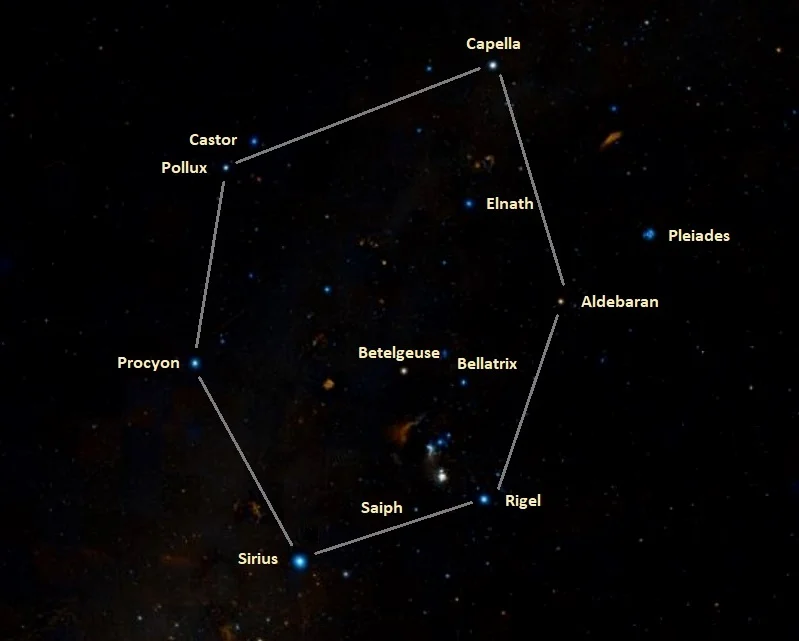
Auriga location, image: Wikisky
Mahasim can be used to find several bright deep sky objects that lie in the same area of the sky. The open cluster Messier 37 lies just east of the imaginary line connecting Mahasim and Elnath, the southernmost star of Auriga’s pentagon.
The area between Mahasim and Hassaleh contains the open clusters Messier 36, Messier 38 and NGC 1893, the emission nebulae IC 417 (the Spider Nebula) and IC 410 (the Tadpole Nebula), and the emission and reflection nebula IC 405 (the Flaming Star Nebula), which surrounds the irregular variable blue star AE Aurigae.
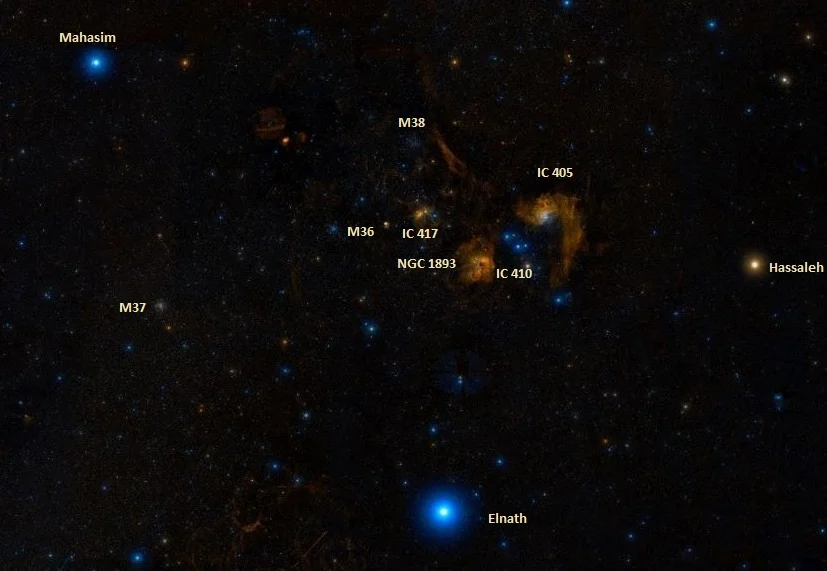
Mahasim, Hassaleh, Elnath, Messier 36, Messier 37, Messier 38 and the Flaming Star Nebula, image: Wikisky
Constellation
Mahasim is located in the constellation Auriga. Representing the Charioteer, Auriga is one of the 48 Greek constellations, first listed by Claudius Ptolemy in his Almagest in the 2nd century CE. In Greek mythology, it is associated with the goat Amalthea, who nursed the young Zeus, and with Erichthonius of Athens, the mythical inventor of the quadriga (the four-horse chariot).
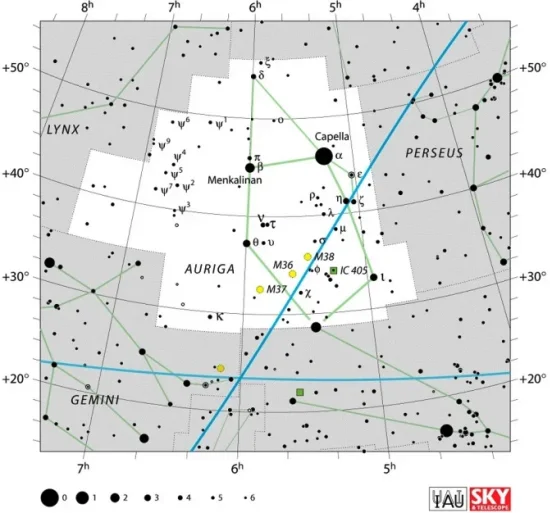
Auriga constellation map by IAU and Sky&Telescope magazine
Auriga is the 21st largest constellation in the sky, stretching across 657 square degrees of the northern sky. It is best known for being home to Capella, the sixth brightest star in the sky, and several other notable stars. These include the Algol variables Beta Aurigae (Menkalinan), Epsilon Aurigae (Almaaz), and Zeta Aurigae (Saclateni), the Orion variable AE Aurigae (a star believed to have formed in the Orion Nebula), and the slow irregular variable Pi Aurigae.
Bright deep sky objects in the constellation include the Flaming Star Nebula, an emission and reflection nebula illuminated by AE Aurigae, and the open clusters Messier 36, Messier 37, Messier 38 (the Starfish Cluster), NGC 1664 (the Kite Cluster), NGC 2281 and NGC 1893, the last of which is embedded in the emission nebula IC 410.
The best time of year to observe the stars and deep sky objects of Auriga is in late February and early March, when the constellation is prominent in the evening sky. The entire constellation is visible from locations between the latitudes 90° N and 40° S.
The 10 brightest stars in Auriga are Capella (Alpha Aur, mag. 0.08), Menkalinan (Beta Aur, mag. 1.90), Mahasim (Theta Aur, mag. 2.62 – 2.70), Hassaleh (Iota Aur, mag. 2.69), Almaaz (Epsilon Aur, mag. 2.92 – 3.83), Haedus (Eta Aur, mag. 3.18), Saclateni (Zeta Aur, mag. 3.70 -3.97), Delta Aurigae (mag. 3.715), Nu Aurigae (mag. 3.957), and Pi Aurigae (mag. 4.25).
Mahasim – Theta Aurigae
| Spectral class | A0pSi + F2-5V |
| Variable type | Alpha2 Canum Venaticorum |
| U-B colour index | -0.18 |
| B-V colour index | -0.08 |
| R-I colour index | -0.06 |
| Apparent magnitude | 2.62 – 2.70 |
| Absolute magnitude | -1.05 |
| Distance | 166 ± 1 light years (50.8 ± 0.4 parsecs) |
| Parallax | 19.70 ± 0.16 mas |
| Radial velocity | +29.30 ± 1.7 km/s |
| Proper motion | RA: +43.63 ± 0.21 mas/yr |
| Dec.: -73.79 ± 0.08 mas/yr | |
| Mass | 3.38 ± 0.08 M☉ |
| Luminosity | 263 L☉ |
| Radius | 5.1 ± 0.4 R☉ |
| Temperature | 10,400 ± 300 K |
| Rotational velocity | 55 km/s |
| Rotation | 3.6187 days |
| Surface gravity | 3.6 ± 0.05 cgs |
| Constellation | Auriga |
| Right ascension | 05h 59m 43.27012s |
| Declination | +37° 12′ 45.3047″ |
| Names and designations | Mahasim, Theta Aurigae, θ Aur, 37 Aurigae, HD 40312, HR 2095, HIP 28380, SAO 58636, BD+37° 1380, AG+37 668, PPM 71083, GC 7557, GCRV 3735, GCRV 3736, PLX 1377.00, JP11 1295, UBV 6064, TYC 2418-1573-1, IRAS 05563+3712, 2MASS J05594324+3712452, ADS 4566 AB, CCDM J05597+3713AB, IDS 05529+3712 A, WDS J05597+3713AB |